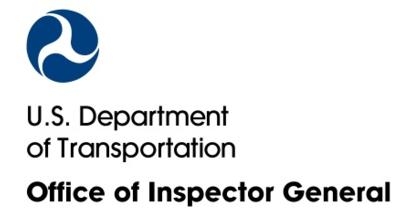Sun, Aug 20, 2017
Does not Include All Capabilities They Expect Will Produce Benefits
The DOT's Office of Inspector General has responded to a request from the leadership of the House Transportation Committee and its Aviation subcommittee concerning a review of the FAA's benefits projection in its July 2016 Next Generation Air Transportation System (NextGen) Business Case.

In its business case, FAA projected that NextGen will deliver about $161 billion in benefits by 2030, of which the Agency states that $2.7 billion has already been delivered to airspace users and the traveling public. At the Chairmen’s request, we provided information on the: (1) programs FAA included as NextGen programs and whether projected benefits represent a realistic assessment, (2) assumptions behind FAA’s benefits calculations, and (3) various groups FAA assumes will benefit and how the benefits are valued.
In the 18-page letter sent to Full Committee Chair Bill Shuster (R-PA) and Frank LoBiondo (R-NJ), Inspector General, Calvin Scovel III said that the office found that the FAA’s benefits estimate is overly optimistic given past experience with introducing new capabilities and the use of out-of-date schedules for some key projects.
The majority of FAA’s estimates are for new capabilities that have not yet been implemented, and some new capabilities continue to face challenges in delivering benefits to airspace users. In addition, while FAA recognizes that the key assumptions behind its benefits calculations are aggressive, the Agency does not provide alternative outcomes or adjust for risks that may impact the delivery of benefits to airspace users. Further, FAA relies heavily on valuing the time saved by passengers to make a positive business case for NextGen.
While this is a generally accepted practice, some airline representatives are concerned that reporting benefits in one, broad category makes it appear that airlines are receiving more substantial benefits than they actually have achieved.
FAA officials also noted that the business case does not include all capabilities that they expect will produce benefits but have yet to be quantified. As a result, FAA’s business case does not communicate the range of uncertainty or complex factors associated with NextGen implementation.
(Source: DOT OIG)
More News
Light Gun A handheld directional light signaling device which emits a brilliant narrow beam of white, green, or red light as selected by the tower controller. The color and type of>[...]
“We have performed extensive ground testing by comparing warm up times, full power tethered pulls, and overall temperatures in 100 degree environments against other aircraft >[...]
While Taxiing To Parking The Right Landing Gear Leg Collapsed, Resulting In Substantial Damage Analysis: The pilot made a normal approach with full flaps and landed on the runway. >[...]
From 2014 (YouTube Edition): Exotic Rebuild Reveals Aerial Work Of Art During EAA AirVenture 2014, ANN's Michael Maya Charles took the time to get a history lesson about a great ai>[...]
Also: Project Talon, McFarlane Acquisition, Sky-Tec Service, JPL Earth Helo Tests Bombardier has earned a round of applause from the business aviation community, celebrating the fo>[...]
 ANN's Daily Aero-Term (12.13.25): Light Gun
ANN's Daily Aero-Term (12.13.25): Light Gun Aero-News: Quote of the Day (12.13.25)
Aero-News: Quote of the Day (12.13.25) NTSB Final Report: Gippsland GA-8
NTSB Final Report: Gippsland GA-8 Classic Aero-TV: Historically Unique -- Marlin Horst's Exquisite Fairchild 71
Classic Aero-TV: Historically Unique -- Marlin Horst's Exquisite Fairchild 71 Airborne 12.12.25: Global 8000, Korea Pilot Honors, AV-30 Update
Airborne 12.12.25: Global 8000, Korea Pilot Honors, AV-30 Update



